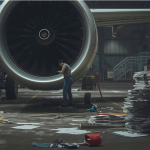 In aviation maintenance, repair, and overhaul (MRO), countless metrics get tracked. From compliance rates to tool calibration checks, every detail matters. But ask any MRO operator what keeps the lights on, and you’ll hear one answer over and over: Turnaround Time (TAT). TAT isn’t just another number on a dashboard. It’s the KPI that dictates whether an aircraft gets back in the air quickly—or whether it sits idle, costing operators hundreds of thousands of dollars a day.
In aviation maintenance, repair, and overhaul (MRO), countless metrics get tracked. From compliance rates to tool calibration checks, every detail matters. But ask any MRO operator what keeps the lights on, and you’ll hear one answer over and over: Turnaround Time (TAT). TAT isn’t just another number on a dashboard. It’s the KPI that dictates whether an aircraft gets back in the air quickly—or whether it sits idle, costing operators hundreds of thousands of dollars a day.
As Suresh Iyer, CEO of Impresa Corp, puts it:
“Every decision in MRO, whether it’s staffing, tooling, or parts availability, should be viewed through the lens of how it impacts turnaround time. TAT is the golden measure.”
Why Turnaround Time Matters More Than Anything Else
Aircraft are profit centers when they’re flying. Every day a plane is grounded, the financial loss mounts. Industry estimates put the cost of an AOG (aircraft on ground) at $150,000+ per day. That’s why reducing turnaround time is directly tied to profitability.
Traditional MRO systems often struggle here. Legacy MRO ERP platforms were built for finance or supply chain functions, not the unique demands of aviation maintenance. They track activity but don’t necessarily accelerate it. This is where next-generation MRO software makes the difference.
People, Parts, Tools, Files, and Data: The Root Causes of TAT Delays
Through years of working with airlines, MROs, and defense organizations, one pattern stands out: TAT delays usually boil down to five factors—people, parts, tools, files, and data.
- People: Technicians and inspectors may lose valuable time navigating outdated interfaces, re-entering data, or chasing down certifications.
- Parts: Inventory mismatches or slow supply chains stall critical work. Even a small missing part can keep a multi-million-dollar asset on the ground.
- Tools: Uncalibrated or unavailable tools delay entire workflows, creating compliance risks and unnecessary downtime.
- Files: Maintenance manuals, service bulletins, or engineering orders stored in disparate systems waste technician time and risk errors.
- Data: Incomplete, siloed, or outdated data prevents timely decision-making, hiding problems until they become costly delays.
An effective MRO management platform must simplify these bottlenecks, embedding checks into everyday workflows so issues are caught early—before they affect the aircraft’s return to service.
How Modern MRO Platforms Cut TAT
Modern aircraft MRO software is designed around the people doing the work. Instead of forcing technicians into rigid ERP workflows, it provides intuitive, role-based tools that simplify documentation, automate compliance checks, and surface real-time insights.
Here’s how:
- Integrated Scheduling: Smart scheduling ensures certified staff are matched to the right tasks at the right time.
- Parts Visibility: Connected MRO inventory systems reduce surprises by showing what’s available, what’s not, and where substitutions can be made.
- Automated Compliance: Built-in checks for labor certifications and tool calibration prevent delays caused by missing approvals.
- Real-Time Reporting: Executives get visibility into TAT performance, while technicians see only what’s needed to move their tasks forward.
This isn’t about replacing ERP—it’s about augmenting it with the best MRO software for the job, one that actually shortens TAT instead of just tracking it.
The KPI That Pays the Bills
At the end of the day, reducing turnaround time isn’t just a metric – it’s the difference between profitable operations and mounting losses. For airlines, MRO providers, and defense organizations, investing in the right MRO solutions pays for itself in faster TAT, better compliance, and stronger margins.
Or as Suresh puts it:
“If you can consistently cut turnaround time, you’re not just improving performance—you’re building a competitive advantage that pays the bills.”
Legacy systems were never built to handle the speed and complexity of modern aviation maintenance. By shifting to purpose-built MRO platforms, organizations can finally move beyond firefighting and start delivering repeatable, measurable improvements in turnaround time.
Because in MRO, TAT isn’t just another KPI—it’s the one that keeps aircraft flying, passengers moving, and revenue flowing.
Explore our capabilities: https://impresa-us.com/impresa-mro/







